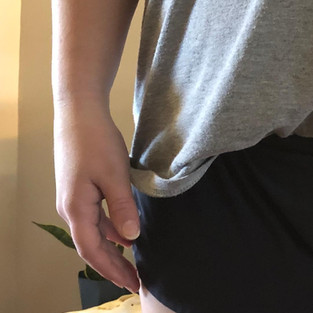Pain Between Shoulder Blades, Internally Rotated Shoulders
- Judy Slater

- Apr 15, 2020
- 2 min read
These are self-care tips to help bring temporary relief while we are dealing with COVID-19 restrictions. These exercises alone probably won't solve the problem because we are addressing symptoms not the root issues like common compensatory patterns caused by muscular imbalances, poor posture, overuse or inactivity. These tips are best used between bodywork sessions as home-retraining exercises recommended by a Myoskeletal Alignment Therapist, Physical Therapist, or a bodyworker who takes a global approach and understands how to assess and treat the underlying issues. For lasting results seek professional help to address the underlying issue and contributing factors.
Pectoralis Major (Chest) Muscle
Symptoms: Internally rotated shoulders, Pain between the shoulder blades, Forward Head Posture, Upper Cross Syndrome
As a society we spend the majority of our lives in flexion. Driving in a car, cooking, gardening, working at a desk, pretty much everything we do our arms are forward with our backs hunched in flexion. This means our chest muscles are shortened for extended periods of time causing our shoulders to round forward and our lower shoulder stabilizers to become weak and over-stretched causing pain and fatigue between our shoulder blades.
Here is a test you can do to see if your shoulders are rounded forward or internally rotated. Stand in front of a mirror or have someone take pictures for you. move your arms around and allow them to just naturally fall to your sides. Now check where your thumbs are pointing. A balanced shoulder girdle will point thumbs forward as in the first picture above. With internally rotated shoulders the thumbs will point across the body as in the second picture. Why should you care? Internally rotated shoulders put added pressure on the Supraspinatus tendon, accelerating fraying which can in time deteriorate to the point of a "rotator cuff' tear. So, yeah, it's kind of important.

The pectoralis or main chest muscle can be stretched many ways. If you suspect damage to this muscle or have a frozen shoulder or if assuming this position causes any pain in the shoulder this stretch is not for you.
An easy way to stretch the chest is to stand with your hips perpendicular to a door jam, raise the arm, placing your forearm on the door frame and lean into the doorway, slightly twisting toward the opposite shoulder. You can lower the elbow a few inches and repeat the stretch to target lower fibers of the muscle as well. Remember, it is always better with a stretch to proceed slowly, ease into it and breath. Don't push yourself too hard or use jerky movements.
This stretch should be done by all of us at least once a day.
Let's reach the entire OKC metro!
Use links at the bottom of each blog to
share with your friends & family!
How to share: Right click on business card image above and select copy then paste in your facebook post or in a text message or email.









Comments